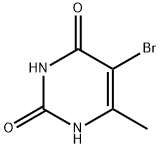5-Bromouracil
Synonym(s):5-Bromo-2,4-dihydroxypyrimidine
- CAS NO.:51-20-7
- Empirical Formula: C4H3BrN2O2
- Molecular Weight: 190.98
- MDL number: MFCD00006017
- EINECS: 200-084-0
- SAFETY DATA SHEET (SDS)
- Update Date: 2024-12-18 14:08:57

What is 5-Bromouracil?
Description
5-bromouracil (5-BU) is a uracil derivative, and its 5' position of the pyrimidine ring is halogenated. If 5-BU is incorporated into DNA in place of thymine, the tautomeric shift will occur, and the 5-BU will base pair with guanine. After the replication, an A-T to G-C transition occurs. Furthermore, the presence of 5-BU within DNA increases the sensitivity of the molecule to UV light. 5-BU is structurally similar to thymine. Therefore, it is considered a thymine analog and base-pairs normally with adenine. It is rarely present in its enol form, where its base pairs with guanine. 5-Bromouracil treats neoplasms in the form of its nucleoside, 5-bromo-2-deoxy-uridine[1-2].
Chemical properties
Prisms from H 2 O.
The Uses of 5-Bromouracil
A major chemical mutagen. Incorporates into DNA, altering base-pair sequencing by replacing thymine
What are the applications of Application
5-Bromouracil is a major chemical mutagen
Definition
ChEBI: A pyrimidine having keto groups at the 2- and 4-positions and a bromo group at the 5-position.
General Description
White powder.
Air & Water Reactions
Insoluble in water.
Reactivity Profile
A halogenated amide. Organic amides/imides react with azo and diazo compounds to generate toxic gases. Flammable gases are formed by the reaction of organic amides/imides with strong reducing agents. Amides are very weak bases (weaker than water). Imides are less basic yet and in fact react with strong bases to form salts. That is, they can react as acids. Mixing amides with dehydrating agents such as P2O5 or SOCl2 generates the corresponding nitrile. The combustion of these compounds generates mixed oxides of nitrogen (NOx).
Hazard
Moderately toxic, alters DNA by replacing thymine.
Health Hazard
ACUTE/CHRONIC HAZARDS: When heated to decomposition 5-Bromouracil emits very toxic fumes of bromide ion and NOx.
Fire Hazard
Flash point data for 5-Bromouracil are not available, but 5-Bromouracil is probably combustible.
Safety Profile
Moderately toxic by intraperitoneal route. Experimental reproductive effects. Mutation data reported. When heated to decomposition it emits very toxic fumes of Brand NOx.
References
[1] Bhagavan, N. and C. Ha. “Chapter 21 – Structure and Properties of DNA.” (2015): 381-400.
[2] Shen, Chang-Hui. “Nucleic Acid-Based Cellular Activities.” Diagnostic Molecular Biology 25 1 (2019): 27-57.
Properties of 5-Bromouracil
| Melting point: | >300 °C (lit.) |
| Density | 1.8710 (rough estimate) |
| refractive index | 1.6200 (estimate) |
| storage temp. | Keep in dark place,Sealed in dry,Room Temperature |
| solubility | <1g/l |
| form | Solid |
| pka | 6.77±0.10(Predicted) |
| color | White |
| Water Solubility | SOLUBLE IN COLD WATER |
| Merck | 14,1445 |
| BRN | 127176 |
| CAS DataBase Reference | 51-20-7(CAS DataBase Reference) |
| NIST Chemistry Reference | 5-Bromouracil(51-20-7) |
| EPA Substance Registry System | 5-Bromouracil (51-20-7) |
Safety information for 5-Bromouracil
| Signal word | Warning |
| Pictogram(s) |
 Health Hazard GHS08 |
| GHS Hazard Statements |
H341:Germ cell mutagenicity |
| Precautionary Statement Codes |
P201:Obtain special instructions before use. P202:Do not handle until all safety precautions have been read and understood. P280:Wear protective gloves/protective clothing/eye protection/face protection. P308+P313:IF exposed or concerned: Get medical advice/attention. P405:Store locked up. |
Computed Descriptors for 5-Bromouracil
| InChIKey | LQLQRFGHAALLLE-UHFFFAOYSA-N |
5-Bromouracil manufacturer
SOLFYN INTERNATIONAL LLP
New Products
(S)-3-Aminobutanenitrile hydrochloride 4-Methylphenylacetic acid N-Boc-D-alaninol N-BOC-D/L-ALANINOL Tert-butyl bis(2-chloroethyl)carbamate N-octanoyl benzotriazole 3-Morpholino-1-(4-nitrophenyl)-5,6-dihydropyridin- 2(1H)-one Furan-2,5-Dicarboxylic Acid S-2-CHLORO PROPIONIC ACID ETHYL ISOCYANOACETATE 2-Bromo-1,3-Bis(Dimethylamino)Trimethinium Hexafluorophosphate 4-IODO BENZOIC ACID 3-NITRO-2-METHYL ANILINE 1-(2,4-DICHLOROPHENYL) ETHANAMINE (2-Hydroxyphenyl)acetonitrile 4-Bromopyrazole 5,6-Dimethoxyindanone 2-(Cyanocyclohexyl)acetic acid 4-methoxy-3,5-dinitropyridine 1-(4-(aminomethyl)benzyl)urea hydrochloride 2-aminopropyl benzoate hydrochloride diethyl 2-(2-((tertbutoxycarbonyl)amino) ethyl)malonate tert-butyl 4- (ureidomethyl)benzylcarbamate Ethyl-2-chloro((4-methoxyphenyl)hydrazono)acetateRelated products of tetrahydrofuran








You may like
-
 51-20-7 5-Bromo Uracil 99%View Details
51-20-7 5-Bromo Uracil 99%View Details
51-20-7 -
 51-20-7 98%View Details
51-20-7 98%View Details
51-20-7 -
 5-Bromo uracil, GR 98%+ CAS 51-20-7View Details
5-Bromo uracil, GR 98%+ CAS 51-20-7View Details
51-20-7 -
 5-Bromouracil CAS 51-20-7View Details
5-Bromouracil CAS 51-20-7View Details
51-20-7 -
 5-bromo uracil 99%View Details
5-bromo uracil 99%View Details
51-20-7 -
 5-Bromo Uracil 51-20-7 99%View Details
5-Bromo Uracil 51-20-7 99%View Details
51-20-7 -
 5-BROMO URACIL Extra Pure CAS 51-20-7View Details
5-BROMO URACIL Extra Pure CAS 51-20-7View Details
51-20-7 -
 5-Bromouracil CAS 51-20-7View Details
5-Bromouracil CAS 51-20-7View Details
51-20-7